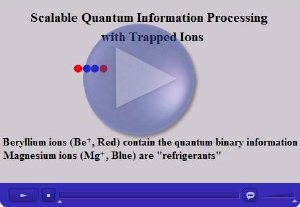Physicists at the National Institute of Standards and Technology (NIST) have demonstrated sustained, reliable information processing operations on electrically charged atoms (ions). The new work, described in the Aug. 6, 2009, issue of Science Express,* overcomes significant hurdles in scaling up ion-trapping technology from small demonstrations to larger quantum processors.
 Animation of the NIST experiment on sustained quantum information processing.
Animation of the NIST experiment on sustained quantum information processing.
In the new demonstration, NIST researchers repeatedly performed a combined sequence of five quantum logic operations and 10 transport operations while reliably maintaining the 0s and 1s of the binary data stored in the ions, which serve as quantum bits (qubits) for a hypothetical quantum computer, and retaining the ability to subsequently manipulate this information. Previously, scientists at NIST and elsewhere have been unable to coax any qubit technology into performing a complete set of quantum logic operations while transporting information without disturbances degrading the later processes.
The NIST group performed some of the earliest experiments on quantum information processing and has previously demonstrated many basic components needed for computing with trapped ions. The new research combines previous advances with two crucial solutions to previously chronic vulnerabilities: cooling of ions after transport so their fragile quantum properties can be used for subsequent logic operations and storing data values in special states of ions that are resistant to unwanted alterations by stray magnetic fields.
The NIST experiments described in Science Express, stored the qubits in two beryllium ions held in a trap with six distinct zones. Electric fields are used to move the ions from one zone to another in the trap, and ultraviolet laser pulses of specific frequencies and duration are used to manipulate the ions’ energy states. The scientists demonstrated repeated rounds of a sequence of logic operations (four single-qubit operations and a two-qubit operation) on the ions and found that operational error rates did not increase as they progressed through the series, despite transporting qubits across macroscopic distances (960 micrometers, or almost a millimeter) while carrying out the operations.
The NIST researchers applied two key innovations to quantum-information processing. First, they used two partner magnesium ions as "refrigerants" for cooling the beryllium ions after transporting them, thereby allowing logic operations to continue without any additional errors due to heating incurred during transport. The strong electric forces between the ions enabled the laser-cooled magnesium to cool down the beryllium ions, and thereby remove heat associated with their motion, without disturbing the stored quantum information. The new experiment is the first to apply this "sympathetic cooling" in preparation for successful two-qubit logic operations.
The other significant innovation was the use of three different pairs of energy states within the beryllium ions to hold information during different processing steps. This allowed information to be held in ion states that were not altered by magnetic field fluctuations during ion storage and transport, eliminating another source of processing errors. Information was transferred to different energy levels in the beryllium ions for performing logic operations or reading out their data values.
The research was supported in part by the Intelligence Advanced Research Projects Activity. For more details, see "NIST Demonstrates Sustained Quantum Processing in Step Toward Building Quantum Computers."
* J.P. Home, D. Hanneke, J.D. Jost, J.M. Amini, D. Leibfried and D.J. Wineland. Complete methods set for scalable ion trap quantum information processing. Science Express. Posted online Aug. 6, 2009.